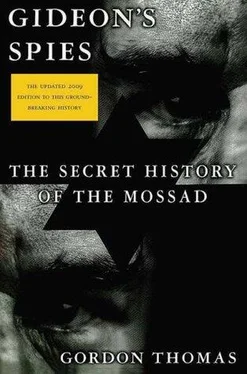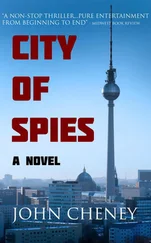Gordon Thomas - Gideon's Spies
Здесь есть возможность читать онлайн «Gordon Thomas - Gideon's Spies» весь текст электронной книги совершенно бесплатно (целиком полную версию без сокращений). В некоторых случаях можно слушать аудио, скачать через торрент в формате fb2 и присутствует краткое содержание. Город: New York, Год выпуска: 2009, ISBN: 2009, Издательство: Thomas Dunne Books, Жанр: История, на английском языке. Описание произведения, (предисловие) а так же отзывы посетителей доступны на портале библиотеки ЛибКат.
- Название:Gideon's Spies
- Автор:
- Издательство:Thomas Dunne Books
- Жанр:
- Год:2009
- Город:New York
- ISBN:978-0-312-53901-6
- Рейтинг книги:4 / 5. Голосов: 1
-
Избранное:Добавить в избранное
- Отзывы:
-
Ваша оценка:
- 80
- 1
- 2
- 3
- 4
- 5
Gideon's Spies: краткое содержание, описание и аннотация
Предлагаем к чтению аннотацию, описание, краткое содержание или предисловие (зависит от того, что написал сам автор книги «Gideon's Spies»). Если вы не нашли необходимую информацию о книге — напишите в комментариях, мы постараемся отыскать её.
Gideon’s Spies
Gideon's Spies — читать онлайн бесплатно полную книгу (весь текст) целиком
Ниже представлен текст книги, разбитый по страницам. Система сохранения места последней прочитанной страницы, позволяет с удобством читать онлайн бесплатно книгу «Gideon's Spies», без необходимости каждый раз заново искать на чём Вы остановились. Поставьте закладку, и сможете в любой момент перейти на страницу, на которой закончили чтение.
Интервал:
Закладка:
Day after day the planning for the assassination continued. Instructors at their desert base checked every detail with the kidon : the language they would speak, the clothes they would wear, the reason why they had come to Syria out of season. The answer to that, given in different ways, was they each wanted a quiet holiday and one they could afford. Like the rest of their cover stories, it was believable from the way they dressed and spoke.
In between, the three men still had much to study and memorize: the roads to the Iranian Cultural Center, the routes from across the city, the area where they could find a lock-up garage, the location of the dead-letter box where the explosives had been left for them to kill Imad Mughniyeh. The material would be placed there by the Beirut sayanim . How and when he did so would remain one of the secrets of the operation moving to its climax.
Meir Dagan had tasked Israel’s own spy satellite, Trescas, to mount surveillance in the area of Damascus where the Iranian Cultural Center was situated. Mossad had priority over all the country’s military agencies for such an operation.
Day by day images were downloaded and studied by photo interpreters in the Kirya, the IDF headquarters in Tel Aviv, looking for any sign of Mughniyeh. There were several “possibles,” but none that matched the photo in the file Reuben had sent. The silent search from outer space continued. Dagan had “a gut feeling” the terrorist would be going to the Iranian celebration at the cocktail party, he told his Director of Operations.
On Saturday, February 9, 2008, the three kidon made their way to Tel Aviv airport to catch their flights to Vienna, Paris, and Frankfurt. A week before, Reuben had received the file from his informer and transmitted it to Tel Aviv. By nightfall, the three kidon were in their airport hotels waiting for their flights to Damascus the following day.
On their cell phones was a close-up of Mughniyeh’s face, which had been altered in that former Stasi clinic near the River Spree.
On Sunday morning, February 10, 2008, Pierre boarded Air France Flight AF 1519 at Charles De Gaulle airport for the journey to Damascus. The sun was setting over the city when he arrived. From Madrid, Manuel had flown on Jordanian Airways Flight RJ 110 to Amman and then on to the Syrian capital. An hour later, Ludwig’s Alitalia Flight AZ 7353 had left Milan’s Malpensa airport in mid-afternoon and arrived in Damascus at 6:30 P.M. local time.
Shortly after, the three men—untroubled by Syrian immigration and customs officers—stowed their carry-in bags in the trunk of the hired car and, with Pierre at the wheel, drove into the city. By late evening they had driven past the dead-letter box and located the lock-up garage which the Beirut sayanim had said would suit their purpose. Satisfied that neither the dead-letter box nor the garage were under surveillance, they picked up the explosives, the small portable radio, and the key to the lock-up garage left in the box. Behind the door of the garage, they worked to prepare the bomb, which would be concealed inside the radio and placed in the car’s headrest on the passenger side. By dawn they had finished.
Taking turns to stand watch, the three kidon slept in the car for most of the day. Late that afternoon, they drove around the city finally passing the Iranian Cultural Center. It was bigger than the sayanim ’s photographs had suggested. It stood on a road with exit routes close by. The plan they had devised would work. Satisfied, the team returned to the lock-up garage. There was no sign that anyone had disturbed its door by dislodging the piece of cigarette paper placed at the bottom.
What they did for the next twenty hours would remain a mystery.
At 7 P.M. on Tuesday, February 12, the team was back outside the Iranian Cultural Center. Ludwig took up position at one street corner, Manuel another. Pierre drove the hired car further down the street from where the oncoming traffic was approaching. He activated the bomb placed in the headrest. Inside the radio, the timer began to tick. It had a four-hour clock. It was now 7:30.
Guests for the Iranian celebration of the Khomeini Revolution were steadily making their way into the Center. At 8 P.M., the Iranian ambassador arrived and hurried inside. None of the guests resembled the face on the cell phones of the three kidon.
At 9 P.M. a silver Mitsubishi Pajero turned into the street and parked close to where Ludwig and Manuel were standing on opposite sides. For a moment the driver and his passenger sat checking the street.
Then the passenger door opened and Imad Mughniyeh emerged. He wore a dark suit and his beard had been neatly trimmed. He started to walk up the street toward where the hired car was parked. He was level with the vehicle when there was a huge explosion, which blew the car into pieces and beheaded Mughniyeh. Later, some of his body parts were found twenty meters away.
Which of the kidon was the first to trigger the bomb would remain unknown. But before the first screaming guests ran from the Iranian Cultural Center reception, and the police and ambulances arrived, the three assassins had vanished.
It would later be suggested in some reports that a car had been left for them in a nearby side street and Pierre had driven the team to a predetermined pick-up point in the south of Syria for an Israeli air force helicopter to collect them. Eyewitnesses would claim they saw a helicopter flying out to sea. Another report said they had left Damascus airport on night flights to Europe. But nobody would ever know.
On the Friday, February 15, following his assassination, Mughniyeh was buried at a huge Hezbollah funeral in Beirut from where he had first launched his terrorist activities. His mother, Um-Imad, sat amid a sea of black chadors, a somber old woman who wailed that her son had planned to visit her on what had turned out to be the day after he had died.
A few days later, she received an envelope. Inside was a copy of one of the pictures taken of Mughniyeh’s face when he had undergone his successful plastic surgery. He had been her third son to die in a Mossad car bombing.
CHAPTER 30
A PERSONAL NOTE
Any account of a secret intelligence service is the real expression of a nation’s subconscious, the history of the nation it serves. For any nation, the first line of defense is knowledge. Nowhere is this truism more apt than in the State of Israel and its relationship with Mossad.
This book is an updated edition of the one I first published eleven years ago. At the time, it was generously described by Meir Amit, a former director-general of Mossad, as an account which “tells it like it was—and like it is.” While other critics have praised the book in similar terms, the truth is that no work about an intelligence service can ever hope to unravel the full story of its activities. How close I came, the reader can judge; the one certainty is that no non-Israeli writer has ever been permitted to come so close. Mossad understandably guards its secrets jealously and with whom it shares some of them. I learned more than I ever expected in the two-and-a-half years I originally spent working with , not for , Mossad to research, write, narrate, and produce the only film the service has allowed to be made of its activities. Called The Spying Machine , the documentary was shown on Britain’s Channel-4 network and elsewhere in the world. It, too, received generous praise.
Since then I have maintained a close professional relationship with the spies of Israel and other services. Though some of them have become friends, my work is far from that of the embedded journalists who have become too often sycophants of wars since the September 11 attacks. The spies I have had the privilege to know are also far removed from the Bond image. They believe that unpleasant facts about their work should be faced, and that they are readily cast in the mold of Thomas Beckett, in a world where lies spin faster and faster.
Читать дальшеИнтервал:
Закладка:
Похожие книги на «Gideon's Spies»
Представляем Вашему вниманию похожие книги на «Gideon's Spies» списком для выбора. Мы отобрали схожую по названию и смыслу литературу в надежде предоставить читателям больше вариантов отыскать новые, интересные, ещё непрочитанные произведения.
Обсуждение, отзывы о книге «Gideon's Spies» и просто собственные мнения читателей. Оставьте ваши комментарии, напишите, что Вы думаете о произведении, его смысле или главных героях. Укажите что конкретно понравилось, а что нет, и почему Вы так считаете.












